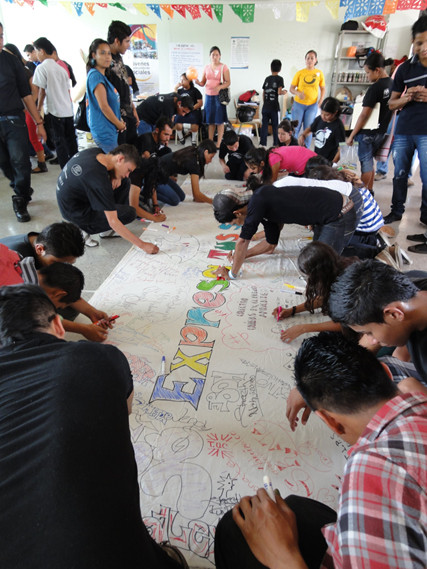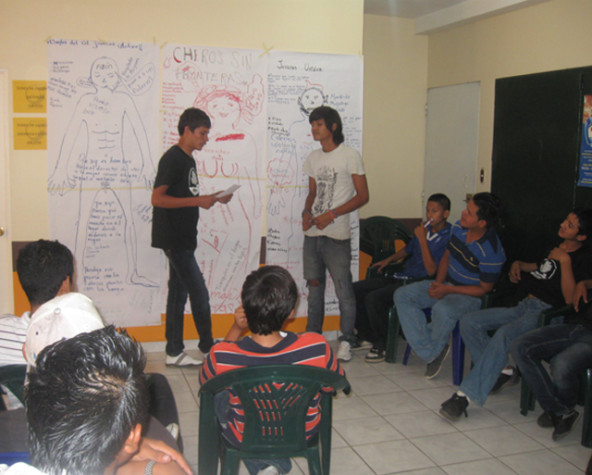 Youth Summit, El Salvador 2012. (Photo courtesy of Avancemos-Ashoka)
Youth Summit, El Salvador 2012. (Photo courtesy of Avancemos-Ashoka)
A lot of wonderful research has been done on frameworks for social innovation. As we set up our social innovation management program at the Amani Institute, we looked for frameworks that fit our experience and observations over our combined 25 years of social entrepreneurship work. The one that we like most was the 5-Step Framework proposed by the authors of The Innovator’s DNA, but its focus on technology and business innovators makes it incomplete on the social innovation front. We also felt there was useful thinking to add from schools of thought such as design thinking, systems change, and adaptive leadership. Thus, we re-framed some of the framework’s ideas and added others to create what we’re calling, for teaching purposes, the Amani Social Innovation Framework (ASIF).
We detail the seven elements of the ASIF below, using for clarity an example from my work with Ashoka when I set up a youth social entrepreneurship project called Avancemos in extremely marginalized and violent communities in El Salvador. Although we at Amani have used the ASIF intuitively, even subconsciously, throughout our careers, across multiple fields and contexts, this example presents a clear case of the framework in action.
1. Burning: Addressing a difficult challenge requires a good understanding of your own personal motivation for doing so. It requires an alignment of self and work, passion and purpose.
Coming from a family of educators, and born in exile in Venezuela because of lack of freedom in my native Argentina, I had worked on youth issues across Latin America since the age of 14. Years later, when Ashoka asked me to launch an office in El Salvador, where I hadn’t been before and didn’t know anyone, I didn’t ask about the salary or working conditions—I just said yes! Leading a project around youth social entrepreneurship in a country with one of the highest rates of homicide per day combined many things I truly believe in: youth, education, social entrepreneurship, and peace building. I was burning to do it.
Are you enjoying this article? Read more like this, plus SSIR's full archive of content, when you subscribe.
2. Sensing: Borrowing from design thinking, social innovation requires that we use all our senses to engage in “problem-finding.” Two hours after landing in the capital city of San Salvador, I asked a taxi driver to drive me around the city so I could see it with my own eyes. He brought his family along! The next day I met with the leader of a local organization to understand what was happening in the country. In less than 24 hours, I started to get a Salvadorian sense of the city in which I now lived. I talked with more locals, including parents and government officials; visited schools; met representatives of international agencies; and read every book and watched every documentary available about youth and maras (gangs).
3. Questioning: One of the most distinguishing behaviors of innovators is asking the right questions—questions others are not asking. In San Salvador, I heard repeatedly, “Youth are violent because they are poor; they don’t have any other options, so they join the maras.” But though many organizations were fostering entrepreneurship to provide economic opportunities for youth, entrepreneurship was not reducing violence. The issue was not just poverty.
One afternoon, I met a youth who told me that he could have ended up like his brother who was killed by the maras. Our conversation was meant to be five minutes but lasted two hours, because I kept asking questions to understand the full dimension of what he was trying to tell me. It also ultimately revealed that the root of youth violence was not poverty alone. I asked many “whys” and “hows,” and I listened a lot. He told me that the day he was going to join the maras, he saw some kids hip-hop dancing and discovered that he loved it. He found his passion and a way to make a living, as well a support network (through which he found our program). He said that saved his life.
It wasn’t easy to find the root of the problem (and you always wonder if you are really at the root), but asking questions and reframing the problem is a good way to look for alternatives.
4. Idea Networking: This is the start of idea generation, and it involves sharing your challenge and emerging ideas widely, building a network around it—and not just brainstorming by yourself or within your organization. Typically, we use networking to gain additional resources for ourselves or our work, but with idea networking, the point is to share our challenge freely and see what other people think—to hunt for ideas.
The nonprofit ecosystem in El Salvador is still far from collaborative. Like many other parts of the world, organizations must compete for resources. The only way to achieve our aim of promoting youth as agents of change so they didn’t join the maras was by putting them at the center and putting our organization second. In other words, these young people—not our organization’s growth—were our mission. With this new perspective, we got the attention of the whole system: schools, universities, local government, national government, parents, youth, NGOs, and donors. We were asking people to join a cause, not our team.
5. Associating: This is the cognitive skill of bringing together different ideas to create new opportunities and leads. Before leaving for El Salvador, I was in Washington, D.C. and happened to visit a secondhand bookstall at Eastern Market, where I found Robert Putnam’s pioneering work on social capital, “Bowling Alone.” At the time, I didn’t know how important that book was—it just struck an intellectual chord that made me want to explore the idea further. I came across the idea again shortly thereafter in a World Bank report that described social capital as the glue that holds a society together. Putting those ideas together in El Salvador, I began to think about how social capital might also influence violence prevention, thus applying an idea from a very different context in a new way. I then discovered other projects in El Salvador that were also promoting social capital—but none of them were using social entrepreneurship.
6. Experimenting: Analogous to “prototyping” in design thinking, experimenting means testing your innovation in the real world, and using user feedback to refine and improve the concept. Although this is hard for the traditionally educated practitioner to embrace, as the likelihood of failure and imperfection is high, it is also an important skill for innovators, who view failure as feedback.
We first tested our new model of “social entrepreneurship using social capital” at a local organization, ASAPROSAR, which focuses on reducing child labor and school drop-out among young people. With ASAPROSAR, we adapted the methodology for the local context of El Salvador—and learned a lot in the process. For example, we originally set up the workshops during the harvest season, when young people have to help out on their families’ farms. When only five youth attended (we planned for 50), we discovered our mistake.
We learned other things too—and some of those mistakes were more dangerous. If you don’t experiment early on, you may lose more than time and money. In social innovation work, mistakes can cost lives.
 Youth Workshop, Santa Ana 2012. (Photo courtesy of ASAPROSAR)
Youth Workshop, Santa Ana 2012. (Photo courtesy of ASAPROSAR)
7. Impacting: Social innovation doesn’t end with the manifestation of the idea; it needs to have impact. Every innovator knows that there are more challenges in executing an idea than in generating one. Impacting means refining the idea based on more user feedback, creating a baseline and evaluation mechanism to respond to this feedback, and trying to scale what works.
Today, the Avancemos project is impacting not only the lives of youth, but also whole communities across El Salvador and now in Honduras. It’s working with more than 12 local organizations and 27 government bodies, and trains more than 1,500 youth. Other important partnerships—with the Youth National Council, for example, extends this impact to thousands more.
The ASIF is a work-in-progress. We are extremely keen for feedback and suggestions for further development. One missing piece is the complex process of “navigating” the system or organization in which you seek to implement your idea, steering it through the societal and political interactions that could reduce its effectiveness or derail it completely. Successfully managing this process might require compromises and battles, and will almost definitely need smaller, targeted innovations to make room for the principal one.
We’d love to hear your thoughts as we continue to deepen this framework and use it as a tool in teaching social innovation.
Support SSIR’s coverage of cross-sector solutions to global challenges.
Help us further the reach of innovative ideas. Donate today.
Read more stories by Ilaina Rabbat & Roshan Paul.

